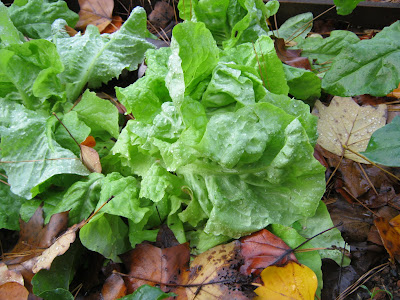Wednesday, November 16, 2011
Autumn Productivity
Over the long summer and early fall, the kitchens of gardeners all across the Southeast are covered up in tomatoes, peppers, okra, and all kinds of beans. Those plants just keep on producing small mountains of food, week after week. There really isn't an equivalent crop, in terms of productivity, for the cooler seasons.
Part of that is just the nature of plants in cool weather; growth slows way down. But part of that is due to what we harvest. Mostly, in the cooler weather crops, we aren't after the fruits. We are after the leaves, the roots, the entire flowering stem.
The closest crops in terms of constant productivity that I can think of, really, are some of the greens. Collards, mustards, and kale, for example, keep on coming, but it takes a lot of greens to fill a pot for supper. From my garden, I can harvest enough greens each week for maybe one meal, right now, but as the temperature drops even more and the growth rate slows, the harvests will slow, too.
Most of us prefer to plant more cool-weather crops than just greens, though. For example, I planted six broccoli plants. If all goes as planned, I will harvest six big heads of broccoli and then some smaller side-shoots, but that will make, at best, enough of the vegetable for eight or nine meals.
The same goes for cauliflower, except that I don't expect any bonus side shoots after harvesting the heads. To be honest, I've never even grown cauliflower before, so I am pleased way-out-of-proportion to what I'm going to get from the six-pack of plants that I bought and planted back in August.
For radishes, one seed makes one small root. Of course, these are delicious, and you can cram quite a lot of them into a fairly small space. The red ones pictured here are "regular" radishes, with a listed 35-days-to-maturity. The white one is a Muncheiner Beer radish, a winter-radish type with a much longer time-to-maturity. The winter radishes can stay in the ground through some very cold weather, so I don't have to worry about bringing them inside as the winter progresses.
Unprotected lettuces keep making new leaves until the first very hard freeze. Around here, that might be as late as mid-December. By mid-January, though, most lettuces left uncovered will have dissolved into a mushy puddle in the garden. This is one of the big, loose heads of Capitan lettuce that I have growing right now:
I have a little cold-frame to fit over the place where the lettuces are planted, but some of these are planted a little too close to the edge of the bed. As colder weather moves in, I'll cut those to the ground to make enough room to fit the cold frame over the lettuces that are more in the middle of the bed.
The garlic that was planted a couple of weeks ago, to grow through the winter and spring, has come up. I love having a crop that overlaps the seasons - when February comes and most of the fall veggies are gone, that promise of good food to come is heartening.
Subscribe to:
Post Comments (Atom)






Everything looks great!
ReplyDeleteYou should try growing wild lettuce, much more hardy. Older leaves should be cooked though..
ReplyDeleteAnonymous,
ReplyDeleteAre you recommending wild lettuces because they are super-productive, or because they hold up well in very cold weather? Just curious. How do they compare in terms of flavor?
The good news is that I have a little cold-frame to set up over my Capitan lettuces (and the one remaining "Marvel of Four Seasons"), so they should be productive and tasty - and not turn into little puddles of green slime - right through the winter.
But thanks for the tip! I will look into wild lettuces as the seed catalogues hit the mailbox.
Hope your garden is doing well!